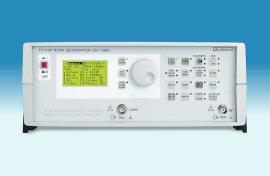|
GV-798+ Features
- Color system: PAL, NTSC and SECAM
- Transmission standards B,G, I, D, K, L, M, N
- Composite video output: 1 Vpp (75 W)
- Adjustable synthesized RF output from 32 to 900 MHz
- DSB or VSB modulation, with progressive attenuation in 1 dB steps
- 22 test patterns 4:3 and 16:9 format
- Outputs: BLACKBURST (PAL and NTSC), RGB, SCART, S-VHS, synchronisms, vertical and horizontal pulses, fixed tones at 1 kHz and 3 kHz
- Inputs: left and right channels sound for Zweiton modulation, video
- Selectable mono multi-standard sound. Stereo/dual Zweiton sound in B, G, D, K, M formats and NICAM sound in B, G, I, L formats
- 99 configuration memories
- Available signals: VITS (Video Interval Test Signals), WSS (Wide Screen Signaling) in 8 formats, FLOP-TELETEXT, VPS and PDC
- Remote control by RS-232
GV-798+ Description
GV-798+ and GV-898+ TV signal generators have the widest selection of functions for an instrument of this type, including the possibility to generate YPb Pr signals. Multistandard and multi-system, 37 different patterns, 16:9 and 3:4 formats, VITS & WSS, teletext, VPS and PDC. Possibility to display messages (clock, text).
All common interface connectors such as S-VHS or SCART are available; the RS-232 interface is specially useful being bidirectional to control the instrument and for data exchange. Output level of up to 80 dBmV with a progressive attenuation in steps of 1 dB.
Specially indicated for those applications where a high quality signal is required, such as adjustment and verification lines, production studios, industrial applications, investigation centers, etc.
The only difference between GV-798+ and GV-898+ models is the RF modulator. The GV-798+ uses a double sideband (DSB) type while GV-898+ uses a vestigial sideband (VSB) approach, similar to the ones used for TV signals broadcast. |
